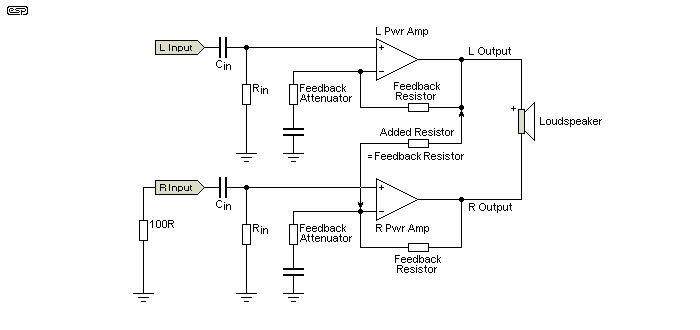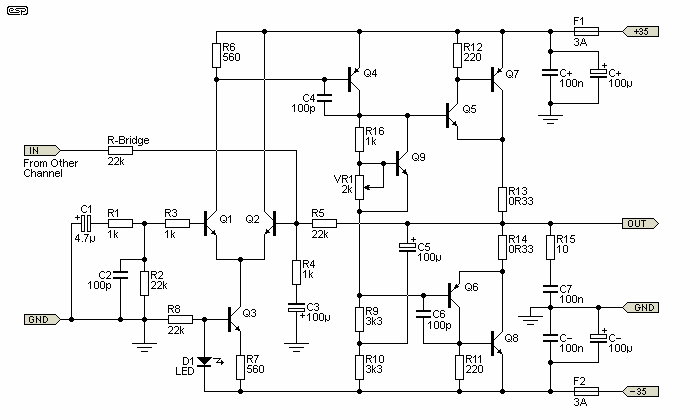

|
| Elliott Sound Products | Project 20 |
In another of my project pages (see Project 14 - Power Amplifier Bridging Adapter), there is a design for a simple add-on bridging adapter for stereo power amplifiers. There is, however, an even simpler way, provided you have (or can trace out) the appropriate section of the amplifier circuit.
Nearly all modern amplifiers use a long-tailed pair as the input and error amplifier (the error amp is the LTP, which detects any variation between its inputs - an error voltage - and corrects it). The input is connected to the base of one of the LTP transistors, and the feedback to the other. The feedback signal is attenuated by the network, by an amount equal to the gain of the amplifier.
By connecting the output of one amplifier to the feedback point in the other, using a resistance equal to that for the feedback resistor, the second amp will have a signal gain of unity, and will be inverted, since the feedback is always applied to the inverting input.

Figure 1 - 'Cross Wiring' Power Amplifiers to Achieve Bridging
Figure 1 shows how this is done, and for clarity, the power amps are shown as opamps (which they are, except they use discrete components and are a bit bigger). The new connections for the 'added resistor' are shown with arrowheads. To make this work, you must be able to positively identify 3 important things:
Do not be tempted to disconnect the feedback attenuator network, since no power amp that I have ever seen is stable at unity gain. "Yes, but ...". I know - I just said that we will make the second channel operate at unity gain, in inverting mode. This is not a problem, since the amplifier still thinks it is operating at its normal gain (typically about 30dB) because the feedback attenuator is still in circuit, and we are attenuating the input signal by using a resistor that is the same value as the feedback resistor.
This is the 'Added Resistor' in Figure 1. Make sure that this resistor is taken from the output point of the amplifier (but before the output inductor if one is used). If taken from an electrically connected point that is not actually the output itself, distortion can be introduced. For example, the end of one or the other power resistor might look as if it is the output, but may have 20 to 50mm of PCB track before reaching the point where the lead to the speaker terminal is taken from. This might not sound like much, but it can make a big difference in distortion.
If you are confused, don't worry. Look at the circuit in Figure 1 again, and you can see what is done. The input of the second amp must be grounded as shown (using an optional 100 ohm resistor) to prevent noise pickup. The resistor is not essential.

Figure 2 - Example Channel 2 Power Amplifier Based On P3A
An example is shown above. This is based on Project 3A, and shows only the 'slave' channel (Channel 2). The other channel (Channel 1) is used normally, and the input signal for the above is taken directly from the output of Channel 1.
I originally used this technique back in the 1970s, and the results were predictable and reliable. A great many amplifiers were built at the time, specifically as bridge amps, with the cross-feedback resistor and secondary input grounding built into the PCB.
The primary advantage of this method of bridging is that no additional components are needed (which means that it is cheap), and there is no requirement for a lower voltage supply to power the opamps needed for a conventional bridging adaptor. The results are at least as good as using an external circuit, but you have to be prepared to modify your amplifier. This is not a good idea if it is under warranty!
There is a negative though. Most amplifiers have a small and usually almost inaudible thump at turn-on and off, and the thump is accentuated by this technique. With some amps the thump can be quite loud, so test it with a junk box speaker first. If this proves to be a problem, use the method described in Project 14.
Always remember that when an amplifier is operated in bridge mode, it appears to be driving ½ the normal load impedance, so make sure each channel of your stereo amp is capable of driving 4 Ohms if you are planning to operate into a standard 8 Ohm loudspeaker. If a 4 Ohm load is contemplated, then each amp must be able to operate with a 2 Ohm load. Check the specifications for the amp before you proceed, or the smoke will escape from the transistors, which will then no longer work ¹.
If desired, a SPDT switch may be used to allow the amp to be switched from bridge back to normal mode. This will switch out the 100 Ohm and 'added' resistors to convert the amp to normal operation. Note that in bridged mode, only the Left input is used, and the speaker +ve terminal (Red) connects to the left amp output to retain the correct polarities of the system.
¹ There is a popular theory that all electronic equipment actually uses smoke internally to function, so when it escapes, the device can no longer work. Practical experience seems to bear this out, and I have never seen a device work after the smoke got out. So much for all that university stuff about 'holes', 'majority carriers' and electrons. (Note: Insulated wire must have a huge amount of smoke in it, because it will continue to work even after it has filled the entire workshop with acrid smoke.)
There's another option, which although comparatively expensive is extremely effective. A transformer can be used to create the reverse-phase signal for the second power amplifier, but ideally the transformer will have dual secondaries to ensure that the signal level is close to identical for each channel. The schematic is shown below.

Figure 3 - Transformer Based Bridging Circuit
The two channels of the amplifier are driven from anti-phase windings of the transformer. The signal source can be balanced or unbalanced, and should be a fairly low impedance. No Zobel networks have been shown for the transformer secondary, as these are specific to a particular component. Where necessary, the manufacturer will generally provide the information. The required transformer impedance is based on the source impedance, but 10k is likely to work well for most systems.
You must ensure that the transformer can handle the maximum level required to get full power from the amplifiers. This depends on the system and the lowest frequency of interest. Amps used for bass will need a larger transformer than those used at higher frequencies (assuming the use of active crossovers). For further information on line-level transformers, see Transformers For Small Signal Audio.
 Main Index
Main Index
 Projects Index
Projects Index